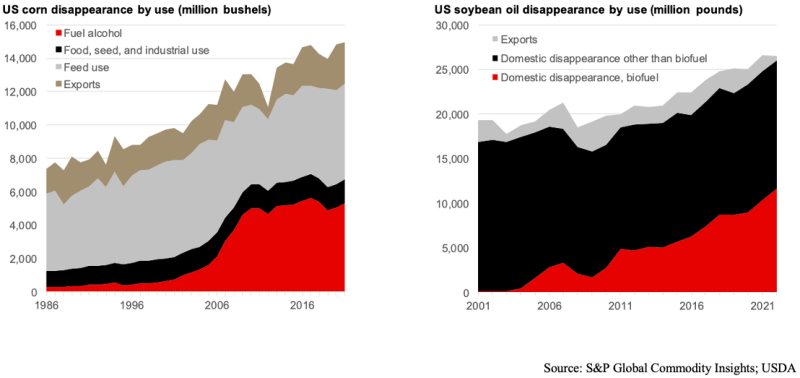The high inflation of recent years can be compared to the 1970s, although it was a very different economy. Central banks raised interest rates in both periods to contain the headline rate. In contrast to the past, food inflation has not eased this time around. This article will address the underlying reasons.
There are several reasons why food prices are more resilient to monetary policy than other goods and services. Food represents a basic need; consumers buy it even when food costs rise. They are also subject to influences from trade policies, supply chains and, increasingly, the effects of climate change and its extreme events.
The conflict between Russia and Ukraine led to a disruption in food exports, which in turn caused an increase in the prices of fertilisers, wheat, maise and sunflower oil globally. It exposed the concentration of commodity production, as the two countries are two of the world's largest exporters of these commodities. On a global scale, in the coming years, Brazil leads in the production of coffee, soybeans, corn, sugar and poultry, all of which will be at the expense of the Amazon.
On the other hand, in terms of demand, China has experienced accelerated growth in importing agricultural products, positioning itself as one of the leading importers worldwide. However, chemical inputs used in food processing have experienced reduced costs due to increased production in mainland China.
The use of agricultural products in the energy and industrial sector, such as in the manufacture of inedible oils, alcohols and biodiesel, is increasing rapidly, putting pressure on the price of grains and vegetable oils.

Beyond the material losses generated by natural disasters, climate's economic effects have yet to be considered. Thus far, international trade compensates for bad harvests and reduces climate impact on prices. In the face of natural phenomena such as floods or forest fires, the economic impact tends to be local and generates financial losses at the site where livestock and crops are lost. If the frequency and intensity of these phenomena continue to increase, imports will not be able to cope with such difficulties. Prolonged droughts such as the one that started in 2017 and coupled with large-scale events such as El Niño cause widespread droughts that affect multiple regions and countries. They decrease water availability for irrigation and human consumption, directly affecting crops and livestock. In the absence of water, crops cannot grow, which reduces yields and, in many cases, leads to total crop failure. If it persists for longer, it can lead to population displacement, agricultural land abandonment, subsequent desertification, and arable land reduction. Agricultural production has declined in several regions simultaneously due to widespread droughts, affecting global food supply and causing food prices to rise. As temperatures rise, weather patterns will become more unpredictable. Extreme weather events such as droughts will become more likely and severe. It causes increasing instability in national and global agricultural markets, making it more difficult for rural producers to plant crops. It also increases the risk of financial losses, difficulty in delivering harvests and reduces investments in the sector which may lead to further concentration of land ownership. The impact of the drought on the quality and prices of these products will continue in the coming months. Wine and olive oil production will take several years to recover from the drought. While coffee suffers from changing weather patterns, which make it difficult for beans to grow, in conjunction with the transition to the third wave of coffee ( https://www.iadb.org/es/mejorandovidas/el-efecto-mas-impensado-del-cambio-climatico), governments are beginning to take measures to mitigate the impact of rising food prices. These include food subsidies, assistance, and income transfer programmesaccompanied by investment in agricultural research and development to develop more resilient crops to climate change, improved rural infrastructure to make it more resistant to extreme weather events and provide financial assistance to farmers to help them adapt to climate change.
The effect of climate on the economy has yet to be considered beyond the losses resulting from natural disasters . So far, international trade has served to offset crop failures and mitigate the impact of weather on prices.
In the face of natural phenomena such as floods or forest fires, the economic impact tends to be local, destroying areas with livestock and crops. If the frequency and intensity of these events continue to increase, countries will require more than imports to cope with these difficulties.
El Niño accentuates the six-year-old drought causing further weather alterations affecting multiple regions and countries. These reduce the availability of water for irrigation and human consumption, having a direct impact on crops and livestock. Lack of water impedes crop development, lowering yields and, in many cases, causing total crop failure. If they persist, they can result in population displacement, abandonment of agricultural land, subsequent desertification and loss of arable land.
Agricultural production has declined in several regions simultaneously due to these widespread droughts, affecting global food supply and increasing prices.
As temperatures rise, weather patterns will become more unpredictable, increasing the likelihood and severity of extreme weather events such as droughts. It leads to increased instability in national and global agricultural markets, making it more difficult for producers. It also increases the risk of economic losses, problems in delivering crops on time and a decrease in investment in the sector, which could lead to a further concentration of land ownership.










